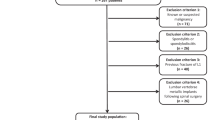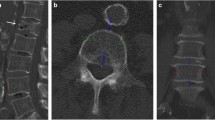Abstract
Objectives
To evaluate the diagnostic power of using vertebral hydroxyapatite concentration measurements in unenhanced and contrast-enhanced spectral CT for detecting and predicting the risk of osteoporosis-associated fractures.
Methods
L1 of 210 patients (105 men, 105 women; mean age, 64 years, range, 19–103 years) who had undergone spectral CT examinations from January 1, 2018, to March 1, 2019, were retrospectively analyzed. Patient data for 3 years after spectral CT were retrieved from electronic medical record information systems to obtain the incidence of osteoporotic fractures. Baseline vertebral cancellous hydroxyapatite concentration from unenhanced and contrast-enhanced late-arterial-phase images was measured. The receiver operating characteristic curves were used to evaluate the diagnostic power for detecting and predicting the 3-year risk of osteoporosis-associated fractures using hydroxyapatite concentrations in both phases.
Results
The hydroxyapatite concentrations in both phases had good diagnostic power to detect fractures at baseline. The sensitivity and specificity for predicting one or more osteoporosis-associated fractures within 3 years after spectral CT were 76.80% and 93.10%, respectively, using the cutoff of 74.79 mg/cm3 in vertebral hydroxyapatite concentration in the unenhanced CT phase, and 82.87% and 82.76%, respectively, using the cutoff of 84.65 mg/cm3 in the late-arterial phase. Furthermore, there was no significant difference in the diagnosis between unenhanced and enhanced CT-derived hydroxyapatite concentrations (p = 0.360).
Conclusions
Both unenhanced and enhanced spectral CT-derived hydroxyapatite concentrations can accurately detect and predict future risk of osteoporosis-associated fractures. The hydroxyapatite concentration assessed in the late-arterial phase may have a similar diagnostic efficacy to that in the unenhanced phase.
Key Points
• A cutoff of 74.79 mg/cm3 of vertebral hydroxyapatite concentration in the unenhanced CT scans had 76.80% sensitivity and 93.10% specificity to predict one or more osteoporosis-associated fractures within 3 years after spectral CT examinations.
• A cutoff of 84.65 mg/cm3 of vertebral hydroxyapatite concentration in the late-arterial-enhanced CT scans had 82.87% sensitivity and 82.76% specificity to predict one or more osteoporosis-associated fractures within 3 years after spectral CT examinations.
• The hydroxyapatite concentration assessed in the late-arterial phase may have a similar diagnostic efficacy to that in the unenhanced phase.




Similar content being viewed by others
Abbreviations
- AUC:
-
Area under the curve
- CI:
-
Confidence interval
- GSI:
-
Gemstone spectral imaging
- MD:
-
Material decomposition
- ROC:
-
Receiver operating characteristic
References
Brown JP, Engelke K, Keaveny TM et al (2021) Romosozumab improves lumbar spine bone mass and bone strength parameters relative to alendronate in postmenopausal women: results from the Active-Controlled Fracture Study in Postmenopausal Women With Osteoporosis at High Risk (ARCH) trial. J Bone Miner Res 11:2139–2152
Kanis JA, Harvey NC, McCloskey E et al (2020) Algorithm for the management of patients at low, high and very high risk of osteoporotic fractures. Osteoporos Int 1:1–12
Kendler DL, Marin F, Zerbini CAF et al (2018) Effects of teriparatide and risedronate on new fractures in post-menopausal women with severe osteoporosis (VERO): a multicentre, double-blind, double-dummy, randomised controlled trial. Lancet 10117:230–240
Cotts KG, Cifu AS (2018) Treatment of osteoporosis. JAMA 10:1040–1041
Barron RL, Oster G, Grauer A, Crittenden DB, Weycker D (2020) Determinants of imminent fracture risk in postmenopausal women with osteoporosis. Osteoporos Int 11:2103–2111
Van Hamersvelt RW, Schilham AMR, Engelke K et al (2017) Accuracy of bone mineral density quantification using dual-layer spectral detector CT: a phantom study. Eur Radiol 10:4351–4359
Koch V, Albrecht MH, Gruenewald LD et al (2022) Impact of intravenously injected contrast agent on bone mineral density measurement in dual-source dual-energy CT. Acad Radiol 6:880–887
Ma Q, Yang Z, Han X, Liu F, Su D, Xing H (2017) Influence of parathyroidectomy on bone calcium concentration: evaluation with spectral CT in patients with secondary hyperparathyroidism undergoing hemodialysis-a prospective feasibility study. Radiology 1:143–152
Ma Q, Hou X, Cheng X et al (2021) Risk of vertebral fractures: evaluation on vertebral trabecular attenuation value and hydroxyapatite concentration in patients by chest spectral CT. Br J Radiol 1119:20200234
Hanley JA, McNeil BJ (1983) A method of comparing the areas under receiver operating characteristic curves derived from the same cases. Radiology 3:839–843
Khosla S (2019) Personalising osteoporosis treatment for patients at high risk of fracture. Lancet Diabetes Endocrinol 10:739–741
Gruenewald LD, Koch V, Martin SS et al (2022) Diagnostic accuracy of quantitative dual-energy CT-based volumetric bone mineral density assessment for the prediction of osteoporosis-associated fractures. Eur Radiol 5:3076–3084
Jang S, Graffy PM, Ziemlewicz TJ, Lee SJ, Summers RM, Pickhardt PJ (2019) Opportunistic osteoporosis screening at routine abdominal and thoracic CT: normative L1 trabecular attenuation values in more than 20 000 adults. Radiology 2:360–367
Allemani C, Matsuda T, Di Carlo V, et al CONCORD Working Group (2018) Global surveillance of trends in cancer survival 2000-14 (CONCORD-3): analysis of individual records for 37513025 patients diagnosed with one of 18 cancers from 322 population-based registries in 71 countries. Lancet 10125:1023–1075.
Johnston CB, Dagar M (2020) Osteoporosis in older adults. Med Clin North Am 5:873–884
Sobecki JN, Rice LW, Hartenbach EM (2021) Bone health and osteoporosis screening in gynecologic cancer survivors. Gynecol Oncol 2:619–624
Buus TW, Rasmussen F, Nellemann HM et al (2021) Comparison of contrast-enhanced CT, dual-layer detector spectral CT, and whole-body MRI in suspected metastatic breast cancer: a prospective diagnostic accuracy study. Eur Radiol 12:8838–8849
Roski F, Hammel J, Mei K et al (2019) Bone mineral density measurements derived from dual-layer spectral CT enable opportunistic screening for osteoporosis. Eur Radiol 11:6355–6363
Acknowledgements
Taking this opportunity, the authors express sincere appreciation to the people who gave our team great support. Yang Zhang, MA, carried out proofreading and improved the language of this paper. This paper cannot conclude without their help and contribution. Hereby again, the study team addresses our sincere gratitude.
Funding
The authors state that this work has not received any funding.
Author information
Authors and Affiliations
Corresponding authors
Ethics declarations
Guarantor
The scientific guarantor of this publication is Qiang Ma and Zhenghan Yang.
Conflict of Interest
Jianying Li works at the CT Research Center, GE Healthcare China.
Statistics and Biometry
No complex statistical methods were necessary for this paper.
Informed Consent
Written informed consent was waived by the Institutional Review Board.
Ethical Approval
Institutional Review Board approval was obtained.
Methodology
• observational study
• diagnostic study
• performed at one institution
Additional information
Publisher’s note
Springer Nature remains neutral with regard to jurisdictional claims in published maps and institutional affiliations.
Rights and permissions
Springer Nature or its licensor (e.g. a society or other partner) holds exclusive rights to this article under a publishing agreement with the author(s) or other rightsholder(s); author self-archiving of the accepted manuscript version of this article is solely governed by the terms of such publishing agreement and applicable law.
About this article
Cite this article
Ma, Q., Hou, X., Zhao, C. et al. Diagnostic power of vertebral hydroxyapatite concentration measurements in spectral CT for osteoporosis-associated fractures and impact of intravenous contrast administration. Eur Radiol 33, 4016–4023 (2023). https://doi.org/10.1007/s00330-022-09383-1
Received:
Revised:
Accepted:
Published:
Issue Date:
DOI: https://doi.org/10.1007/s00330-022-09383-1




